It can be tricky sometimes knowing what to buy in a music store. Below is a selection of my favourite materials and I hope you will get as much enjoyment out of them that I have. I have graded them by difficulty and given a rough guide to the price where available. Please, if you have any recommendations don’t hesitate to contact me.
| Easy |
0 to 2 years of playing |
| Intermediate |
3-5 years of playing |
| Advanced |
5+ years of playing |
METHODS AND STUDIES
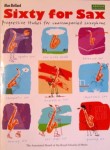 |
| Bullard – Sixty for Sax |
Beginner to Intermediate |
$25 |
Bullard has written a number of works for saxophone, in no small part due to his son being a saxophonist. These studies have a clear character which makes it easier for students to interpret the musical qualities rather than seeing them just as a technical exercise. A huge range of styles are represented from Baroque to 20th Century to Funk. These unaccompanied works represent the range of moods the saxophone can portray and is an excellent way to improve interpretation skills. |
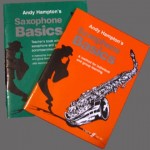 |
| Hampton – Saxophone Basics |
Beginner |
$30 |
Andy Hampton’s beginner method book works for both individual and group instruction, encouraging the teacher to play along with the student in duets or with simple (but effective) piano accompaniments. There are 20 stages which can be completed over 1-2 years of instruction with each stage containing a mixture of solo, accompanied and duet pieces. The technical work had been built into the pieces with the concept of learning being a bit more fun when it’s musical. The teacher’s book is bought separately and contains more challenging saxophone parts and piano accompaniment. The book is fun with lots of cartoons and encourages creativity though improvisation, composition and games. |
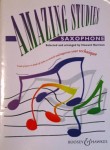 |
| Harrison – Amazing Studies for Saxophone |
Intermediate |
$40 |
Unfortunately most people only get a chance to play a study for an examination or assessment and miss out on the opportunity to regularly improve their technique through a musical piece. This book of studies has been written to cover a wide range of styles with an index linking technical difficulties such as articulation, rhythm, finger technique and tone. There are 76 “enjoyable, ‘real’ pieces” for solo saxophone with a range of styles including folk, baroque, jazz and classical. A great book to have to keep improving technique on the side whilst practicing your core repertore. |
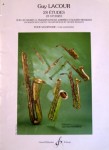 |
| Lacour – 28 Etudes on Modes with Limited Transpositions by Olivier Messiaen |
Advanced |
$40 |
This collection of studies was dedicated to Deffayet whilst he was the professor of saxophone at the Paris Conservotoire. Since the modes are often neglected in our scales practice these studies provide a musical way to improve your finger dexterity, articulation and understanding of less common tonal centers. There are some very musical uses of altissimo but the rhythmic values tend towards the moto perpetuo so that the performer aspires for control and fluency, even at faster tempi. |
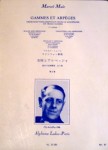 |
| Mule – Gammes et Arpeges 2e Cahier |
Intermediate to Advanced |
$40 |
If you have only played scales as required for examinations, this book will be a real eye opener. Too often we see scales as a chore and don’t give them the time or concentration that they deserve. There is no quicker way to improve technique than scales practice and Mule has given us a taste of how they do it in the big leagues. The blueprint for of the method is provided in major and minor keys where the scales are always full compass, in different note groupings, thirds and arpeggios. There are 3 books in the series, but I have found this second book to be the most beneficial. Get the metronome and learn scales like you never have before! |
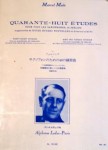 |
| Mule – Quarante-Huit Etudes de Ferling |
Advanced |
$35 |
Ferling wrote 48 studies for oboe that are very suitable to the saxophone due to the similar range. Mule added 12 more studies to cover enharmonic tonalities such at Gb and C# major. A major pedagogical work of the time, each key pairs a slow cantabile movement with a quick and energetic one so that the student progresses in both style and virtuosity. The slower movements are also at excellent tempi to enhance the use of vibrato in phrasing. |
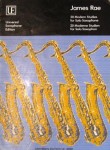 |
| Rae – 20 Modern Studies |
Intermediate |
$25 |
Since its publication in 1989, this book has remained a rite of passage for young saxophonists. The ‘modern’ elements studied in this book include less common time signatures, jazz/blues/rock technique, non-conventional scales and a variety of articulations. The tunes get progressively harder throughout the book and it’s highly recommended for students to learn every study in the book to gain the maximum understanding of style and develop interpretation skills. One book all saxophonists should own. |
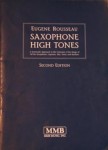 |
| Rousseau – Saxophone High Tones |
Advanced |
$30 |
This is one of my most highly regarded books and it rare to have a week where I am not working on an exercise from it. I believe it is THE book for learning how to play altissimo notes as it develops the skills of overtones, overblowing and venting to allow students access into the upper register of the saxophone. Rousseau has timeless advice along with each topic, bridging exercises and guides to the various modes of altissimo notes. A choice selection of fingerings for all 4 saxophones are provided as well as pages of high tone exercises related to scales and other finger patterns. Even if you do not wish to play a note above high F#, your tone, intonation, flexibility and embouchure will all be improved by these exercises. A MUST HAVE book for advanced saxophonists. |
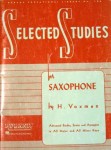 |
| Voxman – Selected Studies |
Intermediate to Advanced |
$20 |
A collection of etudes in all major and minor keys, this is like the USA’s answer to Mule’s Quarante-Huit Etudes de Ferling. Each key has a slow and a fast version which are quite melodious and have clear technique-building finger patterns. The interval study at the back of the book is quite useful for developing flexibility in the embouchure and the scales, scales in 3rds and arpeggios are written full compass. A good collection of studies to supplement technique development. |
JAZZ , IMPROVISATION AND POPULAR
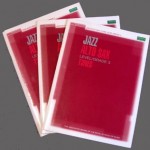 |
| ABRSM – Jazz Saxophone Levels 1-5 |
Easy to Intermediate |
$55 per book |
The Associated Board of the Royal Schools of Music have an excellent jazz examination system that encourage musicians to improvise from day one using music of the highest caliber. The first 3 books contain 15 songs each: five blues and roots, five standards and five contemporary jazz pieces. A range of moods, tempi and changes are provided at each grade as well as an excellent piano accompaniment book and a jazz backing trio on CD. Each level equates to a year of jazz study with the first level book providing an excellent collection of musical tunes that are appealing to beginners. Chord changes are provided as well a guide tones to help start improvising. A real book contains the more challenging level 4 and 5 pieces and 70 other tunes, allowing for an authentic interpretation with fellow jazz musicians. An invaluable resource for improvising and well worth the premium price tag. |
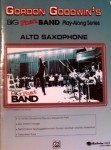 |
| Goodwin – Big Phat Band Play-Along Series |
Intermediate to Advanced |
$30 |
Comprising of some of their most popular tunes from XXL, The Phat Pack and Swingin’ for the Fences, this play along series lets you sit in with the Gordon Goodwin Big Phat Band. The lead part relevant to your instrument is mixed out so you play the part as well as improvising over the changes or reading through transcribed solos by the very talented soloists in the band. Tips on reading the chart and performance notes are given by Goodwin and a lead player to help accelerate your musical development. Goodwin himself says in the introduction “getting to play with highly skilled musicians…that’s the secret to improving your game”. |
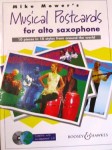 |
| Mower – Musical Postcards |
Intermediate |
$35 |
It’s not often that you get to play authentic music from another country and this book contains 10 songs from different music cultures with play-along tracks performed by genuine ethnic bands. This enticing collection of world music gives students and opportunity to perform in a range of styles with instrumentation that is less familiar. From the Russian Cossackaya! to the Scottish Upland Fling, Musical Postcards is an educational treasure trove and a lot of fun. |
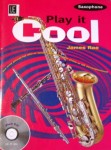 |
| Rae – Play it Cool |
Beginner |
$40 |
This book contains 10 easy pieces for alto or tenor saxophone with piano accompaniment and a CD. The tunes contain repetition of rhythmic figures to assist the learning process and a range of musical styles are represented including blues, funk, rock, reggae and Latin. A great collection of ‘real’ tunes that will help supplement the learning provided by a beginner method book. |
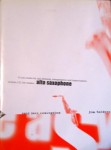 |
| Snidero – Easy Jazz Conception |
Beginner |
$45 |
To learn how to play jazz it’s important to have a solid understanding about the language. This book of 15 etudes has been written with authenticity at the forefront. The heads are written over the progressions of common jazz standards (with names like So Long Birdie, and Prince Charming) and an excellent trio on the backing CD. The phrasing is typical of jazz and the student will be able to learn jazz articulation, the use of space and the effective structuring of a solo. These tunes sound great and an excellent starting point for learning the language of jazz. |
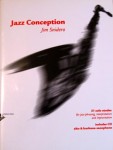 |
| Snidero – Jazz Conception |
Intermediate |
$50 |
Similar in principle to Easy Jazz Conception, this book contains 21 etudes of a range of difficulties. Once again the backing CD is of the highest quality and I would also recommend listen to Snidero play on the demonstration tracks to really absorb the jazz phrasing and his lovely tone. The articulations are only marked for the first 10 etudes so that as the student’s ear develops, they are able to apply their understanding to the more challenging pieces. |
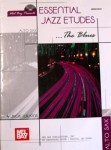 |
| Wilkins – Essential Jazz Etudes: The Blues |
Intermediate |
$30 |
Often when beginning to learn about the blues we get the structure, a nice head and then a blues scale to let rip with. This book provides a little more guidance about the language of a blues solo (as compared to a jazz one) and the use of a variety of scales. There are 12 blues tunes in a variety of styles including bossa, big band and bebop. Each has a head, a few choruses of a transcribed solo, and a chord progression to allow to you improvise and study particular licks or patterns you like. A great way to build your knowledge of the blues and apply it with a great backing CD. |
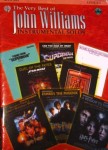 |
| Williams – The Very Best of John William’s Instrumental Solos |
Intermediate |
$20 |
John Williams has written many famous film themes and this book presents selections from Star Wars, Harry Potter and Superman. With the full orchestral sounds synthesized, the backing tracks have a textural weight with them that helps it feel like you are playing in the band. It’s always nice having a few fun and familiar tunes to play at the end of your practice and this book fill that ticket nicely. |
LITERATURE
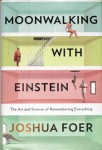 |
| Foer – Moonwalking with Einstein |
|
$27 |
Subtitled ‘The Art and Science of Remembering Everything’, this book looks at how our memory works, the role memorization has played in various cultures and the techniques used by today’s memory athletes. Although it does not focus on music I found the theories quite relevant, including how an expert’s memory works. Written in an engaging style from the perspective of a layman who begins his journey down the path of memorization to quite astounding results. |
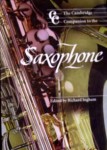 |
| Ingham – The Cambridge Companion to the Saxophone |
|
$50 |
As one of the more ‘modern’ instruments, the saxophone has a well documented evolution from humble beginnings where it was given a ‘flying kick’ at the Brussels Exhibition of 1841 to Delangle’s writings of the contemporary saxophone today. It’s through an understanding of history that we can better grasp the present and this wide collection of articles have been contributed by the most learned saxophonists of our present day from all fields of music. A thoroughly enjoyable read and essential for saxophonists to understand their lineage and possibilities for the future. |
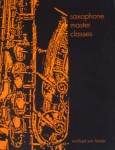 |
| Hester – Saxophone Master Classes |
|
$20 |
This book is a compendium of saxophone knowledge which gives sound principles in saxophone playing. Hester has written chapters on embouchure, air pressure and breathing, articulation, vibrato, altissimo and practicing – sharing the knowledge he has been given by his teachers (Londeix, Rousseau, Sinta, Teal, Kynaston). It is a valuable collection of knowledge for the saxophone student and teachers will find it useful to refine instructional technique. A more recent publication than Teal’s Art of Playing Saxophone, this book is also less weighty and gives some modern approaches to learning. Just like a university class, but from the comfort of your own practice room. |
 |
| Isserlis – Why Beethoven Threw the Stew |
|
$15 |
It can be tricky to relate to composers as regular people, particularly when you’re playing music that has been written hundreds of years ago. But Isserlis has a talent for bringing out the character of six of the ‘great composers’ with captivating stories about their life and how their music was received at the time. Each composer (Bach, Mozart, Beethoven, Schumann, Brahms and Stravinsky) is given a ‘character portait’, a brief description of the music and a short biography with more stories relating to their lives. A must if you are learning music by any of these composers and overall very entertaining reading – keep your eye out for the sequel Why Handel Waggled his Wig. |
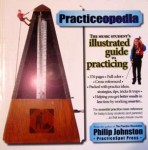 |
| Johnston – Practiceopedia |
|
$35 |
Practicing your instrument is fundamental to your development and for a huge majority of the time, you will be by yourself in a room. The best practice isn’t necessarily the longest, it’s the most efficient, and the practiceopedia gives you a toolkit of 61 different strategies to help you work smarter. Learn how to manage deadlines, stay focused and setup your own practice suite. Excellent for students a Upland Flingnbsp; nd invaluable for teachers, Practiceopedia is a pedagogical tour-de-force. |
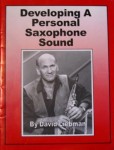 |
| Liebman – Developing a Personal Saxophone Sound |
|
$25 |
The tone of a musician is one of their most distinguishing and powerful characteristics and one of the first things perceived by a listener. Liebman’s book takes the reader on a journey to understanding the physical and acoustical properties behind sound production and encourages them to build a solid concept of their own sound. Much of the concepts and research come from Liebman’s study with saxophone great Joseph Allard and contains valuable exercises and diagrams that will be useful to the student and teacher alike. |
 |
| Rousseau – Marcel Mule: His Life and the Saxophone |
|
$100 |
This book about the Godfather of saxophone, written by one of his most influential students is a must for any serious saxophonist. Notoriously difficult to find in English, the French version is much more widely available. It begins with a comprehensive biography of Mule’s life followed by a series of conversations with Mule on performance, performers, composers, music and teaching. A wonderful way to learn about the development of the classical saxophone and compendium of timeless pedagogical information. |
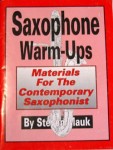 |
| Mauk – Saxophone Warm-Ups |
|
$25 |
In the foreword to this book Mauk compares the warm-up routine of a musician with an athlete. Whilst the musician will often say something like “a couple long notes and my exam scales” or “I don’t really warm-up” and athlete will give a detailed set of exercises designed to prepare them for a specific event. Mauk sought advice from 47 professional saxophonists who are experts in a variety of styles to share ideas on what they do as a warm-up. A base warm-up routine is sketched out containing long tone and vibrato studies, intonation studies, finger exercises, chromatic scale passages, wide leap exercises, extended scale patterns and altissimo, chromatic scale patterns. A highly useful book that will ensure you are getting the best possible start to your practice. |
 |
| Prochnik – In Pursuit of Silence |
|
$20 |
One of my all-time favourite books, this one was found purely by chance during a bookstore browse. Prochnik looks at the dichotomy between our search for silence and addiction to volume. Covering a broad range of environments, we are taken to retail stores, meditation retreats, a car audio competition and quiet space projects. Rather than focusing on what is good and bad, Prochnik “examines why we began to be so loud as a society, and what it is that gets lost when we can no longer find quiet.” |
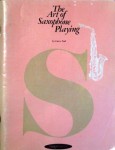 |
| Teal – The Art of Saxophone Playing |
|
$30 |
Published in 1963, Teal’s book is a guide to saxophone skills that extends the technique of an amateur musician to become a craftsman. Topics include reeds, vibrato, intonation, articulation and doubling with a number of illustrations that are still referred to today. The selected literature listed in the back contains a representation of materials used in the “serious study of saxophone” including method books, accompanied work, quartets and reading material. This book will continue to deliver after multiple readings and is ideal for anyone looking to study saxophone at a high level. |
 |
| Werner – Effortless Mastery |
|
$30 |
Musicians are often their own worst critics. To succeed in performance there is an element of baggage that we have to let go of to really allow our enjoyment of music and creativity to shine. Werner offers guidance on dealing with fear and the ego and works towards regaining the effortless mastery of playing music. Available with a CD that has some meditation exercises on it, a valuable asset for dealing with performance nerves and anxiety about playing music. |
ENSEMBLE WORKS
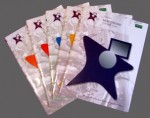 |
| ABRSM – Music Medals for Saxophone |
Easy to Intermediate |
$20 per book |
In response to the number of group lessons being taught in the UK, ABRSM commissioned a series of books containing original compositions for group music lessons. Each book contains a number of duet, trios and quartets for like-saxophones and a combination of Bb and Eb saxophones (this is not SATB music). The difficulty is ranked from copper (absolute beginners) to platinum (4 years of ensemble playing). The pieces are catchy, from a range of styles and adaptable (often a piece will have a more advanced part to cater to mixed level groups). An excellent vehicle for developing small ensemble skills and especially written for saxophonists, by saxophonists. |
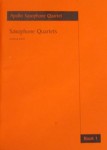 |
| Apollo Saxophone Quartet – Saxophone Quartets Book 1 |
Intermediate |
$35 |
The Apollo Saxophone Quartet is an innovative and exciting ensemble from the UK who have developed original repertoire, drawing upon wide cultural influences and combining the music of classical, jazz, folk and world music. The eight arrangements have been especially written for young saxophonists with AAAA or AAAT and have tantalizing titles like Billy Schizoid and His Unfeasibly Large Intervals or Charm or Smarm? All four parts are of equal difficulty and each member of the quartet gets a chance to play melodic material. One of the best books for teaching small ensemble skills in the secondary school and sequels are available. |
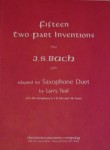 |
| Bach arr. Teal – Fifteen Two-Part Inventions |
Intermediate to Advanced |
$35 |
An invaluable resource for the study and performance of Baroque music, written by the master of counterpoint himself. Teal’s arrangement for saxophone duet is for two like-saxophones or alto and tenor saxophone with both parts of an equal standard. It is faithful to the original keyboard inventions and a guide to stylistic ornamentation is provided. A range of tempi, time signatures and key signatures are provided and each invention will give a greater understand of melody and accompaniment roles, harmonic changes and the use of articulation and dynamics to create interest. These works are too good to just be restricted to keyboard students. |
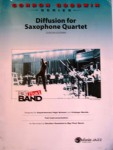 |
| Goodwin – Diffusion for Saxophone Quartet |
Intermediate to Advanced |
$65 |
Better known for his feisty big band compositions, Goodwin was commissioned by the Miles Osland Saxophone Quartet to write a work that “exposes the wide and versatile sounds and stylistic range potential of the saxophone quartet”. The opening Allegro is in a tongue-in-cheek ligit playing style (hunting wabbits anyone?) with light articulations and contrasting textures. This is followed by an up tempo Waltz requiring blend and dynamic control. Swing has lots of space where the quartet’s internal pulse will be honed with the more laid-back feel and tight tutti articulations. The final movement is a tribute to Hip-Hop with the baritone and tenor setting up a shuffle groove before the upper voices join in with opportunities for improvised solos. A modern quartet that should appeal to both classical and jazz fans written by a saxophonist, for saxophonists. |
































